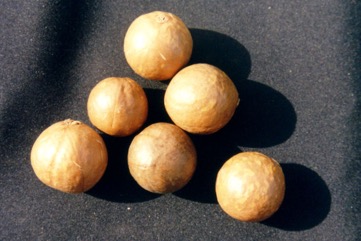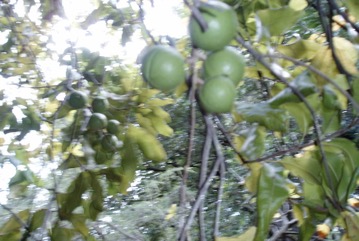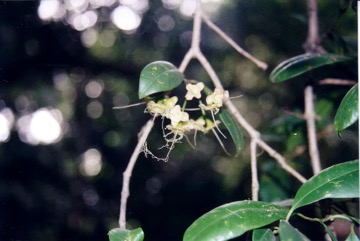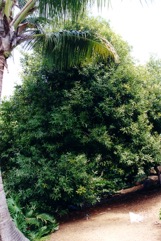Macadamia nut, Smooth-shelled Macadamia

It is a subtropical plant. It grows in the highlands in the tropics. It is native to Australia. In Australia trees grow naturally in rain forests in the subtropics. It suits humid locations. Soils need to be well-drained. They need a sheltered site as they suffer from wind damage. They do best in humus rich soils. They can tolerate light frosts. It has been introduced to other countries from Australia. It does well at 1000 to 1200 m altitude in Papua New Guinea and will grow up to 1700 m. In XTBG Yunnan. It suits hardiness zones 9-11.
Also known as:
Castanha-macadamia, Poppel Nut
Synonyms
- Macadamia ternifolia var. integrifolia (Maiden & Betche) Maiden & Betche
Edible Portion
- Seeds kernel, Nuts
Where does Macadamia nut grow?
Found in: Africa, Asia, Australia, Brazil, Central America, China, Colombia, Cook Islands, Costa Rica, East Africa, Ethiopia, Fiji, Guam, Guatemala, Hawaii, Indochina, Indonesia, Kenya, Malawi, Marquesas, Mexico, North America, Pacific, Peru, Philippines, Samoa, SE Asia, Singapore, Solomon Islands, South Africa, Southern Africa, South America, Tanzania, Thailand, United States, Venezuela, Zimbabwe
Notes: There are about 14 Macadamia species. They are mainly in Australia.
Status: Introduced into Papua New Guinea. Although not yet common in Papua New Guinea it is probably one of the nuts worth promoting. This is the commercial species. It is a cultivated food plant.
Growing Macadamia nut, Smooth-shelled Macadamia
Cultivation: Trees are mostly grown from seed. Seed should be sown fresh. Seeds germinate quickly and easily. They can be grown from cuttings. Plants can be grown by budding or grafting. Pruning increases branching. A spacing of 5 to 10 m is suitable. Many varieties need pollinator trees and bees to assist pollination.
Edible Uses: The nuts are eaten raw although some kinds are roasted. They can be coated with chocolate or carob and used in pastries, candies, ice cream, cakes and pies. The oil can be used with salads and stir-fried dishes.
Production: Nuts are ripe from January to March in Australia. Nuts are harvested after they fall. The outside husk needs to be rubbed off then the nuts dried in the sun.
Nutrition Info
per 100g edible portion| Edible Part | Energy (kcal) | Protein (g) | Iron (mg) | Vitamin A (ug) | Vitamin c (mg) | Zinc (mg) | % Water |
|---|---|---|---|---|---|---|---|
| Nuts | 719 | 7.9 | 3.7 | 0 | 1.2 | 1.3 | 1.4 |
Macadamia nut, Smooth-shelled Macadamia Photos




References
Alice, L. & O'Quinn, T., Australian Bush Superfoods. Explore Australia p 102
Arora, R. K., 2014, Diversity in Underutilized Plant Species - An Asia-Pacific Perspective. Bioversity International. p 95
Barwick, M., 2004, Tropical and Subtropical Trees. A Worldwide Encyclopedic Guide. Thames and Hudson p 257
Bodkin, F., 1991, Encyclopedia Botanica. Cornstalk publishing, p 663
Bonney, N., 1997, Economic Native Trees and Shrubs for South Australia. Greening Australia (SA) inc. Campbelltown SA 5074 p 144
Cheifetz, A., (ed), 1999, 500 popular vegetables, herbs, fruits and nuts for Australian Gardeners. Random House p 199
Cherikoff V. & Isaacs, J., The Bush Food Handbook. How to gather, grow, process and cook Australian Wild Foods. Ti Tree Press, Australia p 200
Coronel, R.E., 1982, Fruit Collections in the Philippines. IBPGR Newsletter p 7
Cribb, A.B. & J.W., 1976, Wild Food in Australia, Fontana. p 88
Cronin, L., 1989, The Concise Australian Flora. Reed. p 155
Cull, B.W., 1995, Fruit Growing in Warm Climates. Reed. p 103
Cundall, P., (ed.), 2004, Gardening Australia: flora: the gardener's bible. ABC Books. p 848
Doran, J.C., & Turnbull, J.W. (Eds), 1997, Australian Trees and Shrubs: species for land rehabilitation and farm plantings in the tropics. ACIAR Monograph No 24. p 306
Elliot, W.R., & Jones, D.L., 1993, Encyclopedia of Australian Plants suitable for cultivation. Vol 6. Lothian. p 263 (Drawing)
Etherington, K., & Imwold, D., (Eds), 2001, Botanica's Trees & Shrubs. The illustrated A-Z of over 8500 trees and shrubs. Random House, Australia. p 452
Facciola, S., 1998, Cornucopia 2: a Source Book of Edible Plants. Kampong Publications, p 189
FAO, 1995, Edible Nuts. Non Wood Forest Products 5.
Flora of Australia Volume 16, Elaeagnaceae, Proteaceae 1. Melbourne: CSIRO Australia (1995) p 422. 421
Flora of China @ efloras.org Volume 5
Glowinski, L., 1999, The Complete Book of Fruit Growing in Australia. Lothian. p 109
Greig, D., 1996, Flowering Natives for Home Gardens. Angus & Robertson. p 253
Haslam, S., 2004, Noosa's Native Plants. Noosa Integrated Catchment Assn. Inc. p 345
Hibbert, M., 2002, The Aussie Plant Finder 2002, Florilegium. p 188
Holliday, I., 1989, A Field Guide to Australian Trees. Hamlyn. p 248
Jones D, L, 1986, Ornamental Rainforest Plants in Australia, Reed Books, p 49, 340
Kiple, K.F. & Ornelas, K.C., (eds), 2000, The Cambridge World History of Food. CUP p 1805
Lazarides, M. & Hince, B., 1993, Handbook of Economic Plants of Australia, CSIRO. p 154
Lorenzi, H., Bacher, L., Lacerda, M. & Sartori, S., 2006, Brazilian Fruits & Cultivated Exotics. Sao Paulo, Instituto Plantarum de Estuados da Flora Ltda. p 476
Low, T., 1991, Wild Food Plants of Australia. Australian Nature FieldGuide, Angus & Robertson. p 92
Low, T., 1992, Bush Tucker. Australia’s Wild Food Harvest. Angus & Robertson. p 89
Macmillan, H.F. (Revised Barlow, H.S., et al) 1991, Tropical Planting and Gardening. Sixth edition. Malayan Nature Society. Kuala Lumpur. p 303
Martin, F. W., et al, 1987, Perennial Edible Fruits of the Tropics. USDA Handbook 642 p 52
Menninger, E.A., 1977, Edible Nuts of the World. Horticultural Books. Florida p 23
Plants for a Future database, The Field, Penpol, Lostwithiel, Cornwall, PL22 0NG, UK. http://www.scs.leeds.ac.uk/pfaf/
Proc. Linn. Soc. New South Wales 21:624. 1897
PROSEA (Plant Resources of South East Asia) handbook, Volume 2, 1991, Edible fruits and nut. p 195
Ratcliffe D & P., 1987, Australian Native Plants for Indoors. Little Hills press. p 103
Recher, P, 2001, Fruit Spirit Botanical Gardens Plant Index. www.nrg.com.au/~recher/ seedlist.html p 2
Robins, J., 1996, Wild Lime. Cooking from the Bush food garden. Allen & Unwin p 109
Ruiters-Welcome, A. K., 2019, Food plants of southern Africa. Ph.D. thesis. Univ. of Johannesburg p 93
Segura, S., et al, 2018, The edible fruit species in Mexico. Genet Resour Crop Evol (2018) 65:1767–1793
Smith, K & I., 1999, Grow your own bushfoods. New Holland. Australia. p 92
Solomon Islands Ministry of Agriculture, 1996, Solomon Islands: Country report to the FAO International Technical Report of Plant Genetic Resources. Leipzig. p 23
Stanley, T. D. & Ross, E. M., 1986, Flora of south-eastern Queensland Volume 2. Queensland Government p 15
Staples, G.W. and Herbst, D.R., 2005, A tropical Garden Flora. Bishop Museum Press, Honolulu, Hawaii. p 469
Tankard, G., 1990, Tropical fruit. An Australian Guide to Growing and using exotic fruit. Viking p 68
USDA, ARS, National Genetic Resources Program. Germplasm Resources Information Network - (GRIN). [Online Database] National Germplasm Resources Laboratory, Beltsville, Maryland. Available: www.ars-grin.gov/cgi-bin/npgs/html/econ.pl (10 April 2000)
van Wyk, B., 2005, Food Plants of the World. An illustrated guide. Timber press. p 236
Wickens, G.E., 1995, Edible Nuts. FAO Non-wood forest products. FAO, Rome. p 33, 147
Williams, J.B., Harden, G.J., and McDonald, W.J.F., 1984, Trees and shrubs in rainforests of New South Wales and Southern Queensland. Univ. of New England, Armidale. p 53, 56
Williamson, J., 2005, Useful Plants of Malawi. 3rd. Edition. Mdadzi Book Trust. p 158
World Checklist of Useful Plant Species 2020. Royal Botanic Gardens, Kew
www.efloras.org Flora of China
www.worldagroforestrycentre.org/treedb/